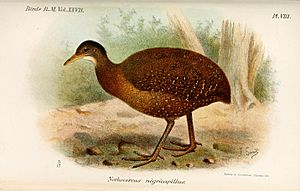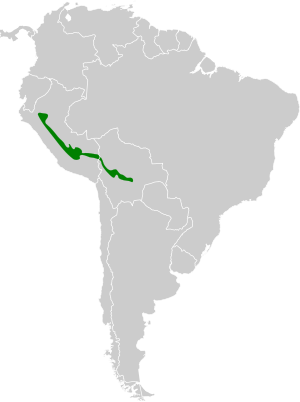Hooded tinamou facts for kids
Quick facts for kids Hooded tinamou |
|
|---|---|
 |
|
| Illustration by Joseph Smit, 1895 | |
| Conservation status | |
| Scientific classification | |
| Genus: |
Nothocercus
|
| Species: |
nigrocapillus
|
| Subspecies | |
|
N. n. cadwaladeri |
|
 |
|
| Synonyms | |
|
|
The hooded tinamou (Nothocercus nigrocapillus) is a special type of ground bird. You can find it living in the forests of Bolivia and Peru.
Contents
What is a Hooded Tinamou?
Tinamous belong to a bird family called Tinamidae. They are also part of a larger group known as ratites. Other ratites include ostriches and emus, which are usually flightless birds.
Unlike most other ratites, tinamous can fly. However, they are not very strong flyers. Scientists believe that ratites evolved from birds that could fly a long time ago. Tinamous are the closest living relatives to these ancient flying birds.
Types of Hooded Tinamou
There are two main types, or subspecies, of the hooded tinamou:
- N. n. cadwaladeri: This type lives in the Andes mountains in northwestern Peru.
- N. n. nigrocapillus: This type is found in the Andes of central Peru and Bolivia.
Where Hooded Tinamous Live
The hooded tinamou makes its home in montane moist forests. These are forests found in mountainous areas. They live at high altitudes, from about 1,550 to 3,000 meters (5,085 to 9,842 feet) above sea level. This bird is native to the Andes mountains in Bolivia and Peru.
What Hooded Tinamous Look Like
The hooded tinamou has light brown feathers on its upper body. These feathers have small black speckles, like tiny freckles. Its underside is lighter in color with faint dark stripes. The belly has pale spots. On average, these birds are about 33 centimeters (13 inches) long.
Hooded Tinamou Behavior and Life Cycle
Like other tinamous, the hooded tinamou mainly eats fruit. They find fruit on the ground or on low-lying bushes. They also eat small amounts of invertebrates (like insects), flower buds, soft leaves, seeds, and roots.
Reproduction
The male hooded tinamou is very involved in raising its young. He incubates the eggs, which can come from up to four different females. After the eggs hatch, he raises the chicks until they are ready to live on their own. This usually takes about two to three weeks. The nest is built on the ground. It is often hidden in thick bushes or between the raised roots of trees.
Conservation Status
The hooded tinamou is listed as "Least Concern" (LC) by the IUCN. This means that its population is currently stable and not at high risk of disappearing. The area where this species lives is estimated to be about 35,000 square kilometers (13,513 square miles).
See also
 In Spanish: Tinamú encapuchado para niños
In Spanish: Tinamú encapuchado para niños


